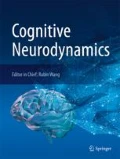Abstract
Contemporary neuroscience research primarily focuses on the identification of brain activation patterns commonly deviant across participant groups or experimental conditions. This approach inherently underestimates potentially meaningful intra- and inter-individual variability present in brain physiological measures. We propose a parameter referred to as ‘individuality index (II)’ that takes individual variability into account. It quantifies the degree of individual variance of brain activation patterns for different brain regions and participants. IIs can be computed based on intra-cerebral source strength values such as the ones derived from the exact low resolution electromagnetic tomography source localization software. We exemplary estimated IIs for simulated datasets. Our results illustrate how IIs are affected by different spatial activation patterns across participants and quantify their distributional properties. They suggest that the proposed indices can meaningfully quantify inter- and intra-individuality of brain activation patterns. Their application to realistic datasets will allow the identification of (1) those brain regions that show particularly heterogeneous activation patterns, the contribution of which is particularly likely to be underestimated by conventional group statistics, (2) those brain regions that can alternatively be recruited by different participants for the same tasks, and (3) their associations with potentially decisive behavioral variables such as individually applied mental strategy.



Similar content being viewed by others
References
Button KS, Ioannidis JPA, Mokrysz C, Nosek BA, Flint J, Robinson ESJ, Munafò MR (2013) Power failure: why small sample size undermines the reliability of neuroscience. Nat Rev Neurosci 14:1–12
Casali AG, Gosseries O, Rosanova M, Boly M, Sarasso S, Casali KR, Casarotto S, Bruno M-A, Laureys S, Tononi G, Massimi M (2013) A theoretically based index of consciousness independent of sensory processing and behavior. Sci Transl Med 5:198ra105. https://doi.org/10.1126/scitranslmed.3006294
Clayson PE, Miller GA (2017) Psychometric considerations in the measurement of event-related brain potentials: guidelines for measurement and reporting. Int J Psychophysiol 111:57–67
De Vico Fallani F, Vecchiato G, Toppi J, Astolfi L, Babiloni F (2011) Subject identification through standard EEG signals during resting states. Conf Proc IEEE Eng Med Biol Soc 2011:2331–2333
Fehr T (2008) Complex mental processing and psychophysiology. Habilitation Thesis. University of Bremen, Germany
Fehr T (2013) A hybrid model for the neural representation of complex mental processing in the human brain. Cogn Neurodyn 7:89–103
Fehr T, Achtziger A, Hinrichs H, Herrmann M (2003) Interindividual differences in oscillatory brain activity in higher cognitive functions: methodological approaches in analyzing continuous MEG data. In: Reinvang I, Greenlee MW, Herrmann M (eds) The cognitive neuroscience of individual differences. bis-Publishers, Oldenburg, pp 101–120
Fehr T, Wallace GL, Erhard P, Herrmann M (2011) The neural architecture of expert calendar calculation: a matter of strategy? Neurocase 17:360–371
Fehr T, Wiechert J, Erhard P (2014) Variability in color-choice Stroop performance within and across EEG and MRI laboratory contexts. Atten Percept Psychophys 76:2495–2507
Fuster JM (2006) The cognit: a network model of cortical representation. Int J Psychophysiol 60:125–132
Fuster JM (2009) Cortex and memory: emergence of a new paradigm. J Cogn Neurosci 21:2047–2072
Hamming R (1950) Error detection and error correcting codes. Bell Syst Tech J 29:147–160
Holmes AP, Friston KJ (1998) Generalisability, random effects, and population interferences. Neuroimage 7:754
Houdé O, Tsourio-Mazoyer N (2003) Shifting from the perceptual brain to the logical brain: the neural impact of cognitive inhibition training. J Cogn Neurosci 12:721–728
Joyce KE, Laurienti PJ, Burdette JH, Hayasaka S (2010) A new measure for centrality for brain networks. Plos One 5:e12200. https://doi.org/10.1371/journal.pone.0012200
Lieberman MD, Cunningham WA (2009) Type I and Type II error concerns in fMRI research: re-balancing the scale. SCAN 4:423–428
McGonigle DJ (2012) Test-retest reliability in fMRI: or how I learned to stop worrying and love the variability. Neuroimage 62:1116–1120
Milz P, Faber P, Lehmann D, Koenig T, Kochi K, Pascual-Marqui RD (2016a) The functional significance of EEG microstates-associations with modalities of thinking. Neuroimage 125:643–656
Milz P, Pascual-Marqui RD, Lehmann D, Faber PL (2016b) Modalities of thinking: state and trait effects on cross-frequency functional independent brain networks. Brain Topogr 29:1–14
Nichols TE, Holmes AP (2001) Nonparametric permutation tests for functional neuroimaging: a primer with examples. Hum Brain Mapp 15:1–25
Pascual-Marqui RD, Lehmann D, Faber P, Milz P, Kochi K, Yoshimura M, Nishida K, Isotani T, Kinoshita T (2014) The resting microstate networks (RMN): cortical distributions, dynamics, and frequency specific information flow. arXiv preprint arXiv:1411.1949
Pirondini E, Coscia M, Minguillon J, Milán JdR, Van de Ville D, Micera S (2017) EEG topographies provide subject-specific correlates of motor control. Sci Rep 7:13229. https://doi.org/10.1038/s41598-017-13582-1
Poldrack RA (2006) Can cognitive processes be inferred from neuroimaging data? Trends Cogn Sci 10:59–63
Schartner M, Seth A, Noirhomme Q, Boly M, Bruno M-A, Laureys S, Barrett A (2015) Complexity of multi-dimensional spontaneous EEG decreases during propofol induced general anaesthesia. Plos One 10:e0133532. https://doi.org/10.1371/journal.pone.0133532
Tan PN, Steinbach M, Kumar V (2005) Introduction to data mining. Addison-Wesley, Reading
Thirion B, Pinel P, Mériaux S, Roche A, Dehaene S, Poline J-B (2007) Analysis of a large fMRI cohort: statistical and methodological issues for group analyses. Neuroimage 35:105–120
Acknowledgements
We would like to especially thank Prof. Dr. Erol Basar (†2017), who encouraged us again and again to think in new innovative directions. The present work was supported by the Schweizer National Fond (Grant Number: IZK0Z3_170893).
Author information
Authors and Affiliations
Corresponding author
Additional information
Publisher's Note
Springer Nature remains neutral with regard to jurisdictional claims in published maps and institutional affiliations.
Rights and permissions
About this article
Cite this article
Fehr, T., Milz, P. The individuality index: a measure to quantify the degree of inter-individual, spatial variability in intra-cerebral brain electric and metabolic activity. Cogn Neurodyn 13, 429–436 (2019). https://doi.org/10.1007/s11571-019-09538-9
Received:
Revised:
Accepted:
Published:
Issue Date:
DOI: https://doi.org/10.1007/s11571-019-09538-9




